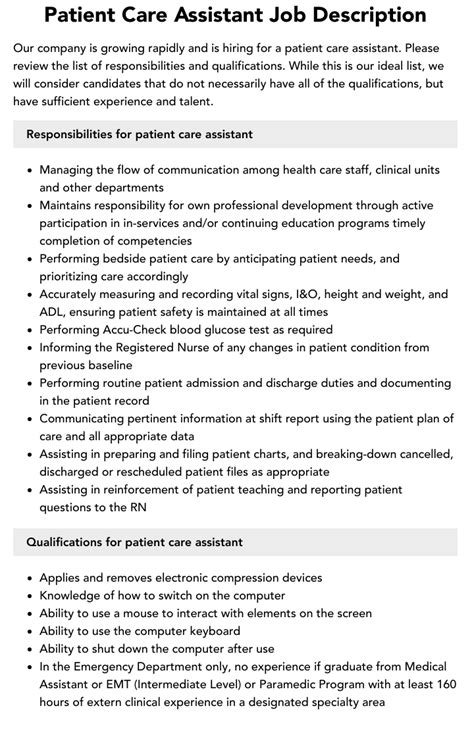Intro
Discover the essential role of a Patient Care Associate (PCA) in healthcare settings. Learn about the PCA job description, responsibilities, and skills required to provide top-notch patient care. Understand how PCAs work with nurses and doctors to deliver compassionate support, vital signs monitoring, and daily living assistance to patients with varying needs.
The healthcare industry is one of the most rewarding and challenging sectors to work in, with various roles that require dedication, compassion, and a passion for helping others. One such role is that of a Patient Care Associate (PCA), a vital member of the healthcare team who plays a crucial part in ensuring the well-being and comfort of patients. In this article, we will delve into the Patient Care Associate job description and responsibilities, highlighting the key aspects of this role and what it entails.

What is a Patient Care Associate?
A Patient Care Associate is a healthcare professional who works under the supervision of a registered nurse (RN) or a licensed practical nurse (LPN) to provide basic care and support to patients. PCAs are also known as nursing assistants, certified nursing assistants (CNAs), or patient care technicians. Their primary goal is to ensure that patients receive high-quality care, are comfortable, and have their needs met.
Key Responsibilities of a Patient Care Associate
The responsibilities of a Patient Care Associate can vary depending on the healthcare setting, patient needs, and the specific requirements of the facility. However, some of the key responsibilities of a PCA include:
- Assisting patients with daily living activities such as bathing, dressing, grooming, and using the bathroom
- Providing basic care and support to patients, including feeding, toileting, and transferring
- Taking vital signs, such as temperature, blood pressure, and pulse rate
- Monitoring patients' conditions and reporting any changes or concerns to the RN or LPN
- Assisting with medical procedures, such as drawing blood or preparing patients for exams
- Maintaining a clean and safe environment for patients, including cleaning and disinfecting equipment and surfaces
- Providing emotional support and comfort to patients and their families
Requirements and Qualifications for a Patient Care Associate
To become a Patient Care Associate, you typically need to meet the following requirements and qualifications:
- High school diploma or equivalent
- Completion of a state-approved nursing assistant program or a patient care associate program
- Certification as a nursing assistant (CNA) or patient care technician (PCT)
- Basic life support (BLS) certification
- Ability to lift, push, and pull heavy objects, as well as stand for long periods
- Excellent communication and interpersonal skills
- Compassion, empathy, and a strong desire to help others

Benefits of Being a Patient Care Associate
Working as a Patient Care Associate can be a highly rewarding and fulfilling career, offering numerous benefits, including:
- Job stability and security
- Opportunities for advancement and professional growth
- Competitive salary and benefits
- Variety and challenge in the work environment
- Sense of purpose and fulfillment from helping others
- Opportunities to work in different healthcare settings, such as hospitals, nursing homes, and clinics
Challenges of Being a Patient Care Associate
While being a Patient Care Associate can be a rewarding career, it also comes with its challenges, including:
- Physical demands of the job, such as lifting and standing for long periods
- Emotional demands of the job, such as dealing with difficult patients and families
- High-stress environment, particularly in emergency situations
- Continuous education and training requirements to stay up-to-date with changing healthcare practices and technologies
- Exposure to infectious diseases and other health risks
How to Become a Patient Care Associate
If you are interested in becoming a Patient Care Associate, here are the steps you can follow:
- Research and enroll in a state-approved nursing assistant program or a patient care associate program.
- Complete the program and pass the certification exam to become a CNA or PCT.
- Gain experience by volunteering or working in a healthcare setting.
- Consider pursuing additional education and training to advance your career.
- Stay up-to-date with continuing education requirements and certifications.

Conclusion
In conclusion, being a Patient Care Associate is a vital and rewarding role in the healthcare industry. PCAs play a crucial part in ensuring the well-being and comfort of patients, and their responsibilities can vary depending on the healthcare setting and patient needs. If you are passionate about helping others and are looking for a challenging and fulfilling career, consider becoming a Patient Care Associate.
We invite you to share your thoughts and experiences about being a Patient Care Associate or working in the healthcare industry. Please comment below or share this article with others who may be interested in this rewarding career.
What is the average salary of a Patient Care Associate?
+The average salary of a Patient Care Associate can vary depending on the location, employer, and level of experience. However, according to the Bureau of Labor Statistics, the median annual salary for nursing assistants, including PCAs, was $30,830 in May 2020.
Do I need to be certified to work as a Patient Care Associate?
+Yes, most states require PCAs to be certified as a nursing assistant (CNA) or patient care technician (PCT). Certification requirements may vary depending on the state and employer, so it's essential to check the specific requirements in your area.
Can I work as a Patient Care Associate in different healthcare settings?
+Yes, PCAs can work in various healthcare settings, including hospitals, nursing homes, clinics, and home healthcare agencies. The specific work environment may vary depending on the employer and the needs of the patients.
